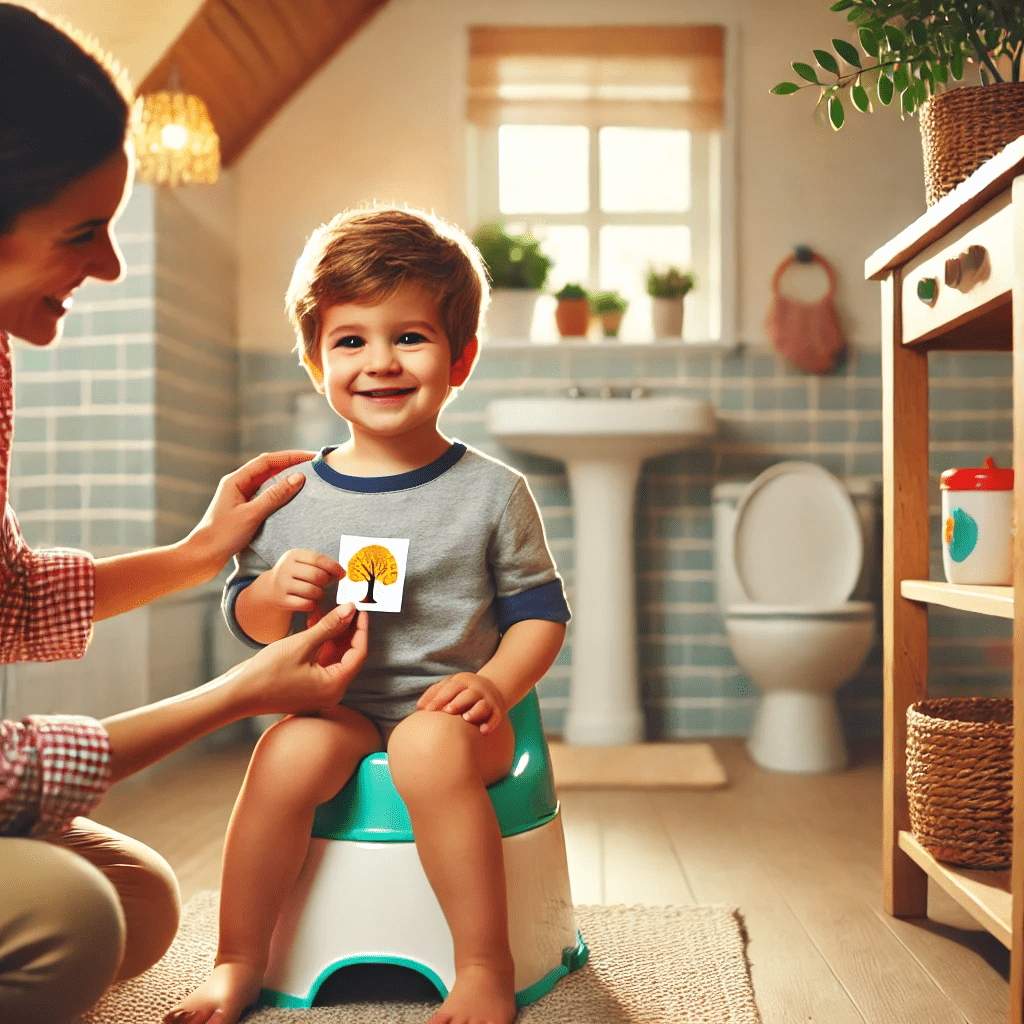Potty training can be a daunting task for many families but using reinforcement strategies rooted in Applied Behavior Analysis (ABA) can make the process smoother and more effective. Reinforcement involves using positive feedback to encourage desired behaviors, and in the context of toilet training, it can be a powerful tool. This approach focuses on rewarding a child for successful attempts or behaviors related to using the toilet, making it more likely that these behaviors will be repeated (Cooper, Heron, & Heward, 2020). Here’s a comprehensive look at how to use reinforcement effectively during potty training and how parents can create a consistent plan at home.
Understanding Reinforcement in Potty Training:
At its core, reinforcement is about providing a consequence that increases the likelihood of behavior happening again (Miltenberger, 2016). When applied to potty training, reinforcement might involve praising a child, giving them a special treat, or offering extra playtime whenever they use the toilet successfully. The key is to ensure that the reinforcement is something the child finds motivating and rewarding. For one child, a sticker might be the ideal reward, while another might be more excited about a few minutes of their favorite video.
It’s essential to differentiate between positive reinforcement and bribery. Positive reinforcement is planned and given after the desired behavior has been completed. For example, if a child sits on the toilet or successfully urinates or defecates, they receive their chosen reward immediately afterward (Schroeder, 2021). This teaches them that using the toilet is a desirable behavior that leads to positive outcomes. On the other hand, bribery involves promising a reward before the desired behavior occurs and is less effective in building long-term habits.
Establishing Clear Goals and Expectations:
Before starting potty training, it’s helpful for parents to set clear and realistic goals. The child should be ready for potty training—showing signs like staying dry for longer periods, being interested in using the toilet, or showing discomfort with wet diapers (Greer & Ross, 2008). When the child shows these readiness signs, parents can introduce the concept of using the toilet and begin explaining what will happen during potty training.
Setting small, achievable goals helps build momentum and keeps the process manageable. The first goal might be simply sitting on the toilet for a few seconds, with praise and a small reward for cooperation. As the child becomes more comfortable, the goal can progress to sitting on the toilet without a diaper, and eventually, to urinating or defecating in the toilet. By breaking the process into manageable steps and reinforcing each success, parents can avoid overwhelming the child and make the process more enjoyable (Cooper et al., 2020).
Choosing Effective Reinforcers:
Choosing the right reinforcers is crucial to the success of using ABA strategies for potty training. Every child is unique, so it’s important to select reinforcers that are meaningful to them. These might include tangible items like small toys, stickers, or snacks, or more abstract rewards like extra playtime, screen time, or engaging in a favorite activity. The key is to make sure the reward is something the child finds truly exciting and worth working towards (Miltenberger, 2016).
It’s also important to vary the rewards over time to maintain their effectiveness. If a child always receives the same sticker, they might lose interest after a few days. Mixing things up can keep the child motivated and engaged in the process. For example, parents might keep a small jar of different rewards and let the child choose one each time they successfully use the toilet.
Using a Reinforcement Schedule:
A reinforcement schedule is a plan that determines how often and when a child receives rewards for their behavior. When beginning potty training, it’s helpful to start with a dense schedule, providing reinforcement each time the child successfully uses the toilet (Schroeder, 2021). This frequent reinforcement helps to establish the behavior and make it a regular part of the child’s routine.
As the child becomes more consistent with using the toilet, parents can gradually move to a thinner schedule of reinforcement. For example, they might start rewarding the child every second or third successful attempt. This gradual shift helps the child learn to continue the desired behavior even without immediate rewards, building their independence and mastery over the skill.
Pairing Reinforcement with Social Praise:
In addition to tangible rewards, social praise is a powerful tool that can enhance the effectiveness of reinforcement. Children often respond positively to enthusiastic praise from their parents, which can help reinforce the desired behavior (Greer & Ross, 2008). A simple “Great job using the toilet!” or “I’m so proud of you for trying!” can make a big difference, especially when delivered with enthusiasm and a smile.
Pairing social praise with tangible rewards helps children associate using the toilet with positive social interactions, making it even more motivating. Over time, parents can phase out tangible rewards and rely more on verbal praise, which is a more natural and sustainable form of reinforcement as the child progresses in their toilet training journey.
Handling Accidents with a Positive Approach:
Potty training is a learning process, and accidents are a natural part of that process. It’s important for parents to remain patient and avoid punishing accidents, as this can create anxiety or fear around toilet training (Miltenberger, 2016). Instead, accidents should be treated as opportunities for teaching. When an accident happens, parents can calmly remind the child about where the toilet is and encourage them to try again next time.
Reinforcement should focus on positive behaviors, such as making an effort to reach the toilet or communicating the need to use the bathroom. This helps keep the child motivated and prevents the process from becoming stressful or discouraging. By maintaining a positive and encouraging attitude, parents can create a supportive environment that helps the child feel safe as they learn this new skill.
Consistency is Key:
Consistency is a cornerstone of successful potty training with ABA techniques. This means applying the same expectations and reinforcement methods each time the child uses the toilet, as well as ensuring that all caregivers (parents, grandparents, babysitters) are on the same page. Consistent reinforcement helps the child understand what is expected and builds a reliable connection between their behavior and the rewards they receive (Schroeder, 2021).
To maintain consistency, it can be helpful to create a potty-training chart. Each time the child successfully uses the toilet, they can add a sticker to their chart, visually representing their progress. Once they reach a certain number of stickers, they might receive a larger reward, like a small toy or a special outing. This visual reinforcement can be a powerful motivator, as children can see their progress and feel a sense of accomplishment.
Celebrating Successes Along the Way:
Potty training can be a long journey, but celebrating small successes along the way can keep the child—and the whole family—motivated. Every step, from sitting on the toilet for the first time to successfully using it multiple times in a row, is worth recognizing. Celebrating these milestones reinforces the child’s hard work and helps them feel proud of their progress.
Parents can celebrate these achievements in ways that are meaningful to the child, whether that’s through a small reward, a special treat, or simply taking a moment to express how proud they are. These celebrations make the process more positive and help to maintain the child’s enthusiasm for learning this new skill.
Conclusion:
Using reinforcement as part of potty training can make the process more effective, positive, and rewarding for both parents and children. By selecting meaningful rewards, maintaining consistency, and focusing on positive reinforcement, parents can help their child develop this important skill with confidence. Patience, encouragement, and understanding are essential throughout the journey, making sure that each step forward is met with support. With these strategies in place, families can approach potty training as an opportunity for growth and connection, turning it into a positive experience for everyone involved.
References
Cooper, J. O., Heron, T. E., & Heward, W. L. (2020). *Applied behavior analysis* (3rd ed.). Pearson.
Greer, R. D., & Ross, D. E. (2008). *Verbal behavior analysis: Inducing and expanding new verbal capabilities in children with language delays*. Pearson Education.
Miltenberger, R. G. (2016). *Behavior modification: Principles and procedures* (6th ed.). Cengage Learning.
Schroeder, S. R. (2021). *Functional behavioral assessment and intervention for students*. Springer.





